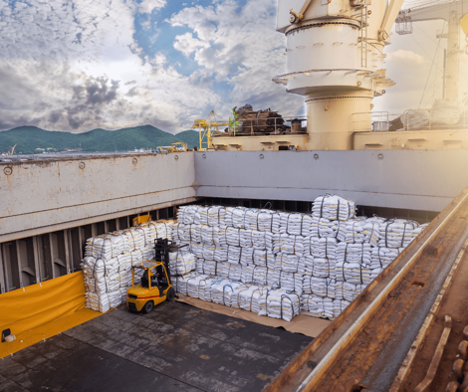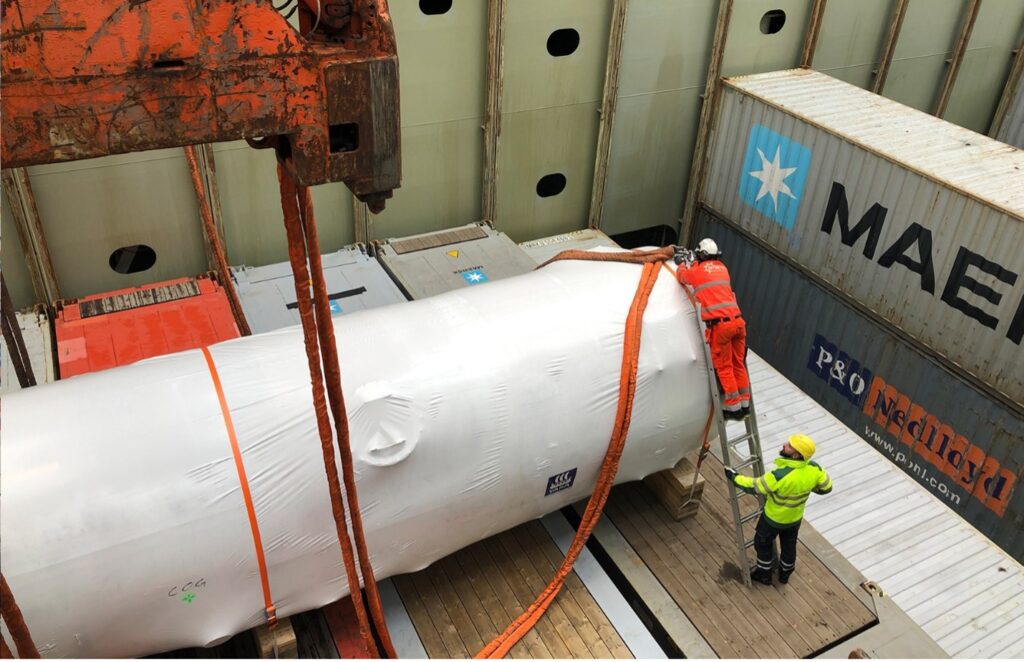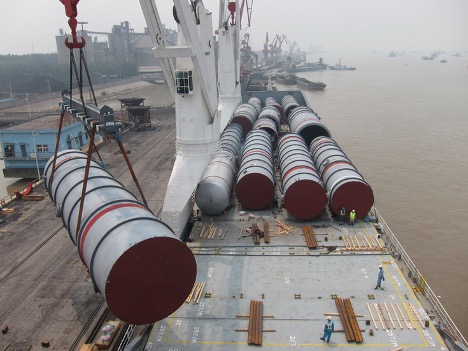Sea transport has been the primary mode of transport for international trade for centuries and remains a popular mode of transport due to its great cargo capacity, low cost, and dependability in all kinds of weather conditions.
For long-distance goods, sea freight transport is often a favored option. There are numerous categories of commodities that are transported via sea transportation, each requiring utilization of a different kind of ship. One such is break bulk cargoes. What does break bulk mean?
Break bulk or general cargo refers to goods that are transported, stowed, and handled piecemeal to some extent, usually bundled in unit loads for hoisting, either with cargo nets, slings, or crates, or stacked on trays, pallets, or skids.

Additionally, break-bulk goods are frequently packaged in smaller containers such as bags, boxes, cartons, crates, drums, or barrels/vats. In this write-up, we shall look at what is meant by the term ‘break bulk cargo, how break bulk cargo is handled, and the benefits and challenges of break bulk shipping.
What Is Meant By The Term ‘Break Bulk Cargo’?
Break-bulk, break bulk cargo, or general cargo in shipping, refers to goods that are stowed on board a ship in individually counted units. General cargo is the term applied to a large number of items that are traditionally recorded on separate bills of lading and which list them by commodity.
In contrast, cargo stored in modern intermodal containers and bulk cargo is delivered directly, unpackaged, and in large quantities into a ship’s hold(s), measured by volume or weight (for instance, oil or grain).
Break-bulk is derived from the phrase breaking bulk—to begin the extraction of a portion of a ship’s cargo or to begin the unloading process from the ship’s hold(s). Ships that transport break-bulk cargo are known as general cargo ships.
Break bulk cargo comes in many different forms. Here are some examples of the most common types: Cargo in bags or sacks, Goods packed in bales, Casks, barrels, and drums, Boxes or containers made of corrugated cardboard and wood, Rolls and reels, Vehicles, equipment, and components, structural steel and steel girders and goods that are long, heavy, or oversized.
For most of history, break bulk was the most common type of cargo. Break bulk cargo has however been declining since the late 1960s, while containerized cargo has grown significantly.
Moving containers onto and off of a ship is far more efficient than moving individual items. This efficiency allows ships to spend less time in ports and more time at sea. Break bulk cargo is also more vulnerable to theft, loss, and damage.
How Is Break Bulk Cargo Handled?
Break-bulk cargo is ideally lifted directly into and out of a vessel’s holds, and this is mostly the case today. Otherwise, cranes or derricks on the dock or on the ship are used to lift the cargo onto and off the deck. Liftable or rollable goods need to be manhandled and stowed competently by stevedores if hoisted on deck rather than directly into the hold.
Dunnage is used to secure break-bulk and general freight inside a vessel. Break bulk has traditionally been manually carried on and off ships, over a plank, or passed from man to man via a human chain when no hoisting equipment is available.

This kind of cargo can be put straight from a truck or train onto a ship, but the most common way is for the cargo to be brought to the dock before the ship arrives and stored in warehouses.
When the ship arrives, the goods are moved from the warehouse to the quay, which is lifted onto the ship either by the ship’s equipment (derricks or cranes) or by cranes on the dock. The ship is unloaded in the opposite direction of how it was loaded.
Loading and unloading by break bulk take a lot of work. The cargo is brought to the dock next to the ship, and each item is then lifted on board one at a time. Some things, like sacks or bags, can be loaded in groups using a sling or cargo net.
Other things, like cartons, can be loaded onto trays before being lifted on board. Once on board, each item has to be put away in its own place.
Why Is Break Bulk Cargo Shipping Still Relevant in Today’s Day And Age?
Break bulk shipping is the process of shipping cargo that is too large or too heavy to be containerized. This type of shipping is still relevant today because it allows for the transport of large and heavy items that would otherwise be difficult to move.
Break bulk cargo, which is currently growing in popularity around the world, therefore allows shippers to use a variety of packaging methods to transport project-related cargo aboard oceangoing vessels.
Additionally, break bulk shipping is often the most cost-effective option for shipping cargo that does not fit into a standard container. While containerized shipping is more popular these days, break bulk shipping still has its place in the world of cargo transport. For certain types of cargo, it is still the best option available.
How Is Break Bulk Cargo Different From Other Types Of Cargo?
There are many types of cargo but break bulk cargo is unique in a few ways.
First, break bulk cargo is cargo that is not packaged in containers or bulk. This means that each piece of break bulk cargo must be handled individually, which often requires special handling equipment.
Second, break bulk cargo is often larger and heavier than other types of cargo, which means that it requires a larger and stronger vessel to transport it.
Finally, break bulk cargo typically has a longer transit time than other types of cargo, since it often needs to be unloaded and reloaded at multiple points along its journey.
What Are The Benefits Of Break Bulk Shipping?
Flexibility in a method of packaging is one of the primary advantages of break bulk shipping. Such packaging flexibility enables shippers to ship absolutely anything they want at once without having to split goods into well-balanced containers, resulting in faster delivery throughout the supply chain.
This becomes useful particularly in project forwarding when a company wants to ship oversized items, as the open-air approach makes this an easy method of moving goods globally when they are awkwardly shaped or sized.
Additionally, because modern transportation systems such as containerization and other similar unitization systems require a huge financial investment which many areas in the world might not have resources to provide for, break bulk, on the other hand, is a very accessible form of shipping because it can be unloaded easily and without the use of heavy cranes or specialized equipment. This, therefore, enables break bulk cargoes to have a greater Global reach for shipments.
Finally, it is a faster way of moving freight as companies do not need to spend time organizing their cargo into containers and other unitization systems. Logistics companies can load cargo directly onto the ship, and pick them up straight away at the destination.

Break bulk, therefore, has an advantage in areas where port development has lagged behind shipping technology. This is due to the fact that it necessitates only a few shore facilities (e.g., a wharf for the ship to tie to, dock workers to assist in the unloading process, or warehouses to store materials for later reloading onto other forms of transport).
Are There Any Challenges Associated With Break Bulk Shipping?
The most difficult aspect of shipping break bulk cargo is that it necessitates more resources and coordination – stevedores, loading and unloading cranes, warehouses, specialized ships, transport vehicles, ship agents, and so on.
Loading and unloading break bulk cargo can be time-consuming. Typically, such cargo is brought to the quay next to the ship, and each individual item is lifted on board separately – often using heavy-duty cranes from the boat or dockside. Each individual item must be secured and stowed separately once on board.
Conclusion
Bulk carriers are one of the most prevalent types of international transportation, with breaking bulk being a very typical shipment method. The majority of ports across the world accept break bulk cargo because of its numerous advantages and flexible and convenient loading and unloading procedure.
Considering this, it is not surprising that the supply chain continues to rely largely on break bulk cargo shipping, as this business is a cornerstone of globalization and international cargo transport.
- Types of Gas Carriers as per IGC Code – April 22, 2025
- Wind-Assisted Propulsion Systems (WAPS): A Game Changer for Maritime Decarbonization – February 6, 2025
- 10 Boat Salvage Yards in California – January 25, 2025





